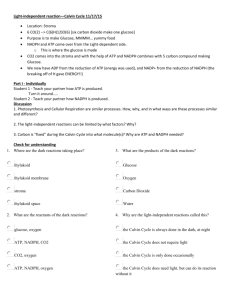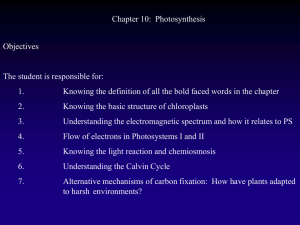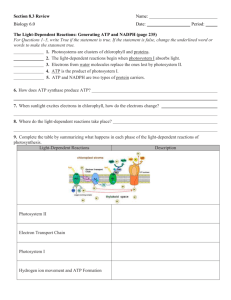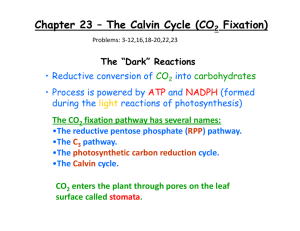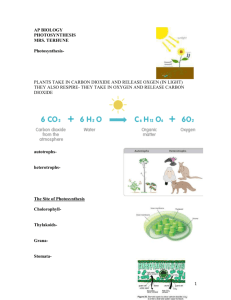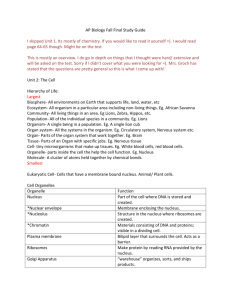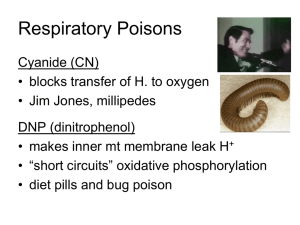PHOTOSYNTHESIS CH 10 I. Overview Synthesis of glucose using
advertisement
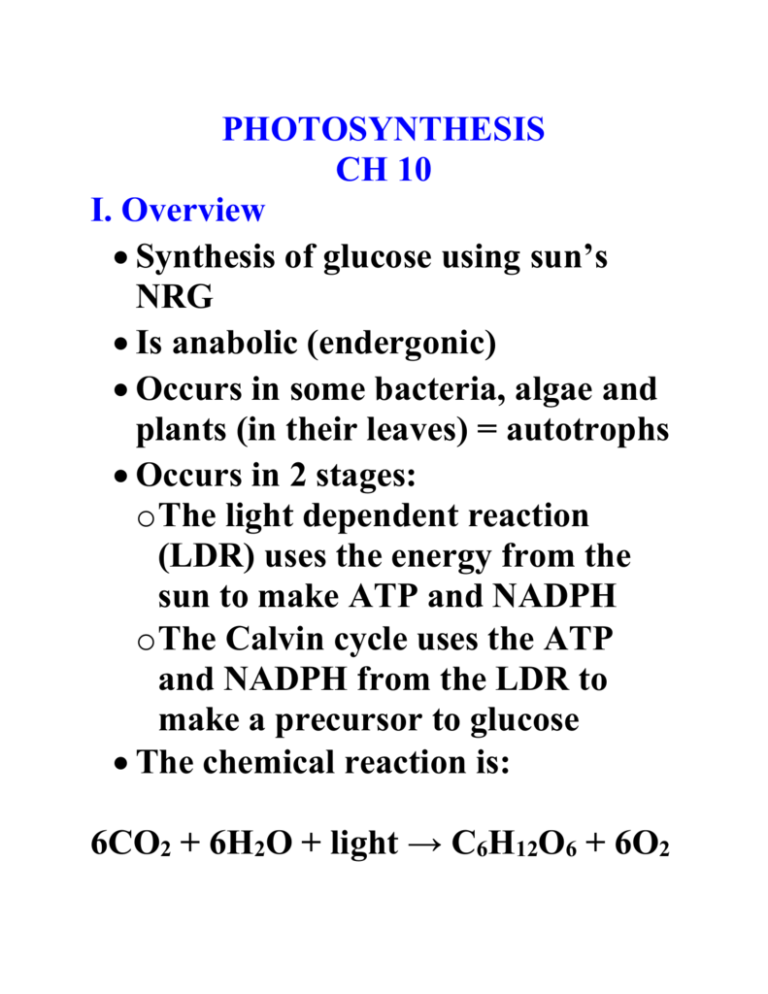
PHOTOSYNTHESIS CH 10 I. Overview Synthesis of glucose using sun’s NRG Is anabolic (endergonic) Occurs in some bacteria, algae and plants (in their leaves) = autotrophs Occurs in 2 stages: o The light dependent reaction (LDR) uses the energy from the sun to make ATP and NADPH o The Calvin cycle uses the ATP and NADPH from the LDR to make a precursor to glucose The chemical reaction is: 6CO2 + 6H2O + light → C6H12O6 + 6O2 II. The chloroplast structurally similar to photosynthetic prokaryotes and most likely evolved from them The LDR takes place in the membranes of the thylakoids The Calvin cycle takes place in the stroma III. The Light Dependent Reaction (LDR) A. Role of light composed of different wavelengths also behaves like it has particle called photons Why does a plant appear green? Chlorophylls absorb the photons of energy from RO IV Chlorophylls found in plants, algae, and cyanobacteria Cyanobacteria are ancestor of chloroplasts Other photosynthesizing bacteria have bacteriorhodopsin which absorbs green wavelengths B. The components of the LDR 1. Photosystem I and II They have: Antenna complex: contains chlorophyll and absorbs photons Reaction center: uses energy from photons to boost electrons. 2. Electron Transport Chain (ETC) series of proteins that transfer electrons by redox reactions 3. Proton pump uses the energy in the electron to pump protons (H+) across the membrane. 4. NADP reductase uses the energy from the boosted electron to make NADPH 5. ATP synthase uses energy from the proton gradient to make ATP C. How the light dependent reaction works There are 2 reactions, noncyclic phosphorylation and cyclic phosphorylation 1. Noncyclic phosphorylation: Used to make BOTH ATP and NADPH Photosystem I and II are used How: o Photon from sun is captured by chlorophyll in photosystem II and is transferred to the reaction center where e- is boosted o The boosted e- is IMMEDIATELY captured by the ETC o The lost e- from the reaction center is replaced by an e- from water 2H2O →4e- + O2 +4H+ o the energy from boosted e- is used to actively transport H+ ions across the thylakoid membrane forming electrochemical gradient o The H+ diffuse DOWN their concentration gradient thru ATP synthase using the stored energy in the proton gradient to make ATP o A photon from the sun is captured by chlorophyll in photosystem I. o This energy is transferred to the reaction center where an e- is boosted o The e- is IMMEDIATELY captured by the ETC o The e- and its energy is transferred to NADP reductase which then makes NADPH In essence, NRG transfer is: eH+ ATP Solar NRG eNADPH http://faculty.nl.edu/jste/noncyclic_pho tophosphorylation.htm http://highered.mcgrawhill.com/sites/0072437316/student_view 0/ 2. Cyclic phosphorylation: Only activated when leaf cell needs more ATP Only Photosystem II is working. Photosystem I is bypassed IV. The Light Independent Reaction A. The Calvin Cycle = C3 photosynthesis It uses ATP and NADPH from the LDR as well as CO2 from the atmosphere to make a precursor to glucose (PGAL) It occurs in the stroma of the chloroplast RUBISCO is the enzyme that fixes CO2 to start the Calvin cycle http://glencoe.mcgrawhill.com/sites/9834092339/student_view 0/chapter39/calvin_cycle.html B. Photorespiration When Rubisco uses O2 instead of CO2 Causes calvin cycle to shut Can occur in C3 plants Factors that can cause photorespiration o High levels of O2 compared to CO2 (O2 acts like competitive inhibitor) o High temps (lowers RUBISCO’s specificity C. Evolutionary pathways that avoid photorespiration 1. C4 photosynthesis CO2 is fixed by another enzyme, that can work with low CO2 levels C4 compound gives CO2 to RUBISCO 2. CAM photosynthesis It is primarily the C4 pathway, but plants keep their stomata open at night when the atmospheric O2 levels decrease http://www.uic.edu/classes/bios/bios10 0/lectures/c4.htm V. How the LDR and Calvin cycle interact

